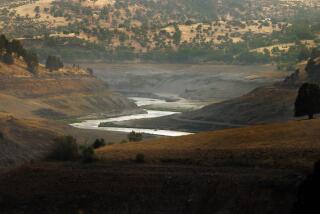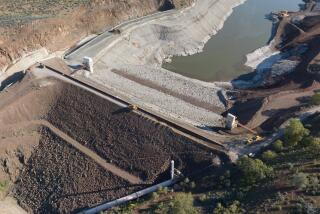In China, Three Gorges Dam’s image showing some cracks
- Share via
Reporting from Yichang, China — White-haired Zhao Chengmu lives just below the Three Gorges Dam, China’s largest construction project since the Great Wall. If the colossal structure fails, the fragile 77-year-old shop owner will be one of the first to die.
But that’s never going to happen, he says.
“This dam will be here for eternity,” Zhao boasts. “Even if this dam is hit by a U.S. missile, it won’t break — it’ll just shake once.”
FOR THE RECORD:
Three Gorges Dam: An article in Monday’s Section A about China’s massive Three Gorges Dam suggested that the 1989 book “Yangtze! Yangtze!” criticized, among other things, shoddy construction in the dam. The dam project did not enter construction until 1993. —
Like Zhao, most Chinese herald their government’s monumental enterprise to defy the mighty Yangtze River, choke off its devastating annual floodwaters and harness its raw power to provide cleaner energy. Such a mammoth engineering feat, they say, only serves to underscore mankind’s supremacy over nature.
Critics consider the dam in less lofty terms: as Beijing’s boondoggle. With an official price tag of $25 billion — and some estimates claiming three times that much — the costliest hydropower project in history demonstrates China’s sheer arrogance in trying to tame nature’s whims, they say, never mind the 3,000 tons of garbage that have been flowing every day into the reservoir recently.
A year after the dam went into full operation, cracks are already showing in the public image of the project. This year’s torrential rains, the nation’s worst in a decade, have severely tested the project’s capacity to control the surging Yangtze, the world’s third-longest river.
Last month, when floodwaters poured into the dam’s 400-mile-long reservoir at 565,000 cubic feet per second, a government official acknowledged that “the dam’s flood-control capacity is not unlimited” and hinted that more severe flooding could even risk the structure’s collapse.
That’s a far cry from the highfalutin claims of just a few years ago. In 2003, officials boasted that the dam could withstand the worst flood in 10,000 years. In 2007, the estimate was reduced to 1,000 years. In 2008, it was dropped yet again, this time to just 100 years.
Many engineering experts are worried about this year.
“The flooding is greater than anyone expected,” said John Byrne, director of the University of Delaware’s Center for Energy and Environmental Policy. “The problems that many people predicted appear to be showing themselves.”
Newspapers here report that the reservoir’s rising water level has increased the likelihood of such hazards as landslides and earthquakes. Officials even say the structure won’t totally stop Yangtze flooding, which has killed an estimated 1 million people over the last century. “It can’t defeat all under heaven,” the project’s deputy operations manager said of the dam.
A project promoted by Chairman Mao Tse-tung, the Three Gorges Dam was long hailed by Communist Party officials as a crafty way to solve several complex problems with one structure.
Damming the Yangtze allows seafaring ships access to the river, with the reservoir able to accommodate the deep-hulled vessels, and open up China’s landlocked interior to economic development. The clean, cheap energy generated by the dam would help wean China off coal-fired power plants, officials said.
Yet in recent years, the government has toned down its boasts on the project, which seems to have fallen out of favor in Beijing’s halls of power. When the dam officially opened in 2006, Chinese leader Hu Jintao was conspicuously absent.
Critics claim the dam’s legion of problems far outweigh its benefits. They point to the reservoir’s silt accumulation that they say will prevent the passage of the deep-sea ships. The dam has also disrupted the migratory routes of several unique fish species, they say.
Many worry the reservoir could turn into a cesspool of sewage, toxins and other pollutants discharged from factories upstream. In recent weeks, the heavy rains have caused thousands of tons of garbage to collect at the dam, threatening to jam its locks. Although tugs and fishing boats have recently helped to collect the garbage, in some spots the trash is still so thick people can stand on it.
For years, journalist Dai Qing has been one of the project’s most vocal skeptics. In 1989, she led an alliance of scientists, engineers and scholars in writing a book called “Yangtze! Yangtze!” outlining alleged corruption and shoddy construction in the project. The book was banned, and Dai was jailed for 10 months for anti-government organizing. Two decades later, she still calls Three Gorges a spectacular mistake.
“They’ve destroyed the Yangtze River, China’s most phenomenal waterway, and caused untold damage to a fragile environment — and those are just the problems we know about,” she said. “Man’s understanding of nature is evolving, but China has always been a half-step behind. But the greedy people in power wanted electricity at any cost.”
The dam’s biggest toll is a human one, many say. More than 1.5 million people were resettled by the project, their land submerged under the dam’s reservoir. Also lost were 1,300 important archaeological sites, many dating back 4,000 years.
Still, many residents in central Hubei province support the project. In Yichang, a city of 4 million, the airport and university are named after the Three Gorges Dam. A huge billboard proclaims: “We’re China’s City of Hydropower and Tourism.”
Each year, hundreds of thousands of tourists scurry along the dam. “From an engineering point of view, it’s pretty impressive what they’ve done,” said Australian Dirk Boettcher. “But even our guide admitted that the environmental impacts of this dam won’t be known for years down the road.”
Nearby, guide Li Liwan said she ignores all the negativity over the project. “I’m impressed by its sheer power,” she said of the dam. “When they open the ducts to let out the water, it really is a thing of beauty. There’s so much water, it creates its own rainbow.”
Yet there’s one place the tour buses can’t visit — the community of Zigui. The town, the onetime home of Chinese poet Qu Yuan, used to be about 45 miles upstream. Years ago, officials relocated residents to a site near the dam before submerging their hometown under millions of tons of reservoir water.
A cigarette tucked behind his ear, restaurant owner Xiong Huajun says he misses his boyhood haunts. “There are lots of memories of the simpler life we had there,” he said. “But there’s no use talking about it — it’s all underwater now.”
Good or bad, experts say, China must live with its dam.
“This was an extremely ambitious project,” said William Mitsch, an environmental and natural resources professor at Ohio State University. “But it’s a lesson we see time and again — you can’t tame nature. You can build your Titanics, but sometimes they sink.”
The elderly Zhao Chengmu is content living in the dam’s shadow, bragging about his son’s work as an engineer on the project.
“Mao Tse-tung never saw this dam in his lifetime,” he said. “But I think he’d be proud of what we’ve done.”
Tommy Yang in The Times’ Beijing Bureau contributed to this report.
More to Read
Sign up for Essential California
The most important California stories and recommendations in your inbox every morning.
You may occasionally receive promotional content from the Los Angeles Times.











